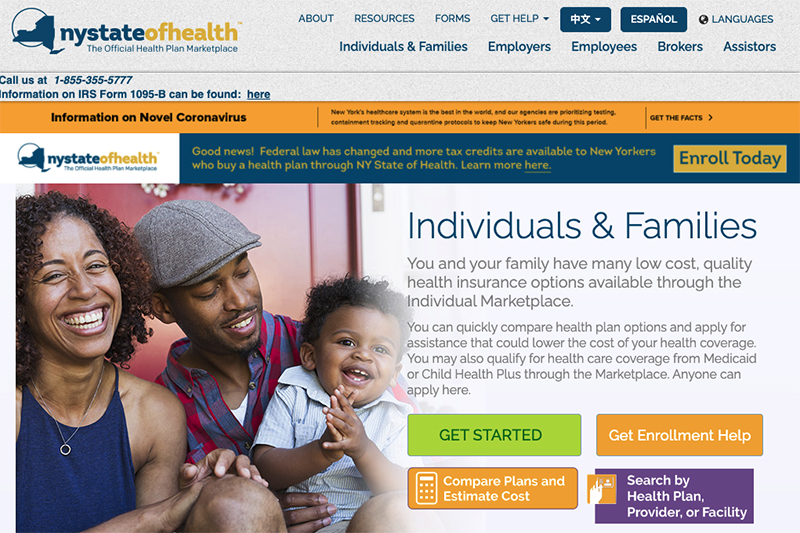AARP Eye Center
What’s new for 2024 open enrollment?
- Key dates: Open enrollment runs from Nov. 16, 2023 through May 31, 2024.
- Where to apply: Visit New York State of Health, the state’s Affordable Care Act (ACA) marketplace.
- What’s changed: The marketplace is staying open longer than usual — through May 2024 — to allow for those losing their Medicaid, Child Health Plus or Essential Plan coverage to enroll in a marketplace plan. However, anyone who is eligible for a marketplace plan can take advantage of the extended open enrollment window. Also, in 2024, families with an offer of job-based insurance that’s newly considered unaffordable may become eligible for savings with New York State of Health plans.
Am I eligible?
Most New Yorkers under 65, including non-U.S. citizens with work or student visas, are eligible to buy health insurance through New York State of Health. People who are incarcerated are not eligible. Find more information on New York State of Health’s website.
Depending on your income, you may qualify for free or low-cost options such as Medicaid, for low-income people and families and people with certain disabilities; Child Health Plus, for those under age 19 who aren’t eligible for Medicaid; or the Essential Plan, for working adults with lower incomes who do not qualify for Medicaid.
Immigrants in New York City have many options for health coverage, depending on their status. Undocumented immigrants and low-income pregnant women may also be eligible for emergency Medicaid.
You’ll learn if you’re eligible when you apply for insurance through New York State of Health. For more information, including income limits, visit the marketplace website.
When can I enroll?
- Open enrollment for 2024 coverage runs from Nov. 26, 2023, through May 31, 2024.
- Year-round enrollment is open to New Yorkers who qualify for the Essential Plan, Medicaid and Child Health Plus.
What if I miss open enrollment?
If you don’t qualify for year-round enrollment, you’ll only be able to buy health insurance after open enrollment if you experience a qualifying life event. Qualifying events include certain moves, births and adoptions, loss of employer-provided coverage, marriage, divorce and other special circumstances. In most situations, you’ll have just 60 days from that event to enroll.
How do I sign up?
Apply for coverage and choose your plan at the same time. You’ll need to pay your first monthly premium for your coverage to begin and to receive health plan cards. To apply and enroll:
- Online: Go to the New York State of Health website and click “GET STARTED” to compare plans and get help enrolling.
- By phone: Call the New York State of Health customer service center at 855-355-5777 (press 5), Monday through Friday, 8 a.m. to 8 p.m., and Saturdays from 9 a.m. to 1 p.m. If you have hearing loss, call 800-662-1220 (TTY enabled).
- In person: Call the New York State of Health customer service center at 855-355-5777 (press 5) to request in-person assistance. Representatives called “assistors” and “navigators” are available to provide enrollment assistance. Assistance is free of charge. Use the New York State of Health online search tool to find an assistor in your community.
What is covered, and how much will it cost?
Coverage and cost depend on where you live, the type of plan you choose, your household income and the age and disability status of you and your family.
All New York State of Health plans cover 10 “essential” benefits, including:
- Emergency services and hospitalization
- Pregnancy, maternity and newborn care
- Mental health services (including counseling)
- Chronic disease management
- Pediatric care
- Prescription drugs
Insurance companies cannot deny coverage because of preexisting conditions. When you apply, you can identify your medical needs and choose a plan that makes financial sense for you and your family.
All New York State of Health plans cover basic dental services for children, including cleanings and exams. But adults who want dental coverage must add it to their policy. Deductibles and out-of-pocket costs vary between plans; enrolling in a family plan can cut costs.
Those who qualify for Medicaid, Child Health Plus or the Essential Plan get comprehensive benefits, including vision and dental benefits, with no monthly premium, no deductible and low-cost copays.
What plans are available?
New York State of Health plans are organized into four categories:
- Bronze plans have the lowest monthly premiums and the highest deductibles and copays, and they cover roughly 60 percent of care costs. They’re designed to help you in case of serious illness or injury.
- Silver plans have moderate monthly premiums, deductibles and copays. They cover roughly 70 percent of care costs. They’re the only plans eligible for cost-sharing subsidies.
- Gold plans have higher monthly premiums and lower deductibles and copays, and they cover roughly 80 percent of care costs.
- Platinum plans have the highest monthly premiums and the lowest deductibles and copays. They cover roughly 90 percent of care costs. These are for people who have significant health care needs and are willing to pay the highest premiums.
New York State of Health’s comparison tool allows you to estimate the costs and benefits of various plans and check whether you might qualify for financial assistance.
Who is eligible for financial assistance for premiums?
The federal government increased tax credits for insurance premiums in 2021 and expanded the number of households that qualify for them. As a result, most people enrolled in ACA marketplace plans have seen their premiums go down. This expanded financial assistance is available through 2025.
- If your annual income is below 150 percent of the federal poverty limit ($21,870 in 2024 for an individual and $45,000 for a family of four), you may be eligible for zero-premium coverage, depending on the plan you choose.
- If your income is between 150 percent and 400 percent of the federal poverty level (up to $58,320 for an individual and $78,880 for a couple) you are eligible for a premium subsidy. The amount depends on your income and your plan.
- If your income exceeds the above limits, you can still get a premium subsidy if your monthly charge for the most popular silver-level plan would be more than 8.5 percent of your income.
If you’re eligible, New York State of Health will automatically apply the credits when you enroll.
Is there any other financial assistance available?
Yes. If you qualify for a premium tax credit, you may also qualify for a cost-sharing reduction that would help you pay for such out-of-pocket expenses as deductibles and copays. You must enroll in a Silver-level plan to get this assistance.
What if I already have health insurance?
- If you or your spouse have job-based insurance, the only way you will qualify for financial help on a New York State of Health plan is if your insurance does not meet minimum standards for affordability and coverage. A job-based health plan is considered unaffordable if the premiums are more than 8.39 percent of the family’s household income.
- If you’re independently enrolled in a private health insurance plan, not through your job, you may qualify for significant savings if you switch to a New York State of Health plan. You can do so during open enrollment.
- If you already have a New York State of Health plan but want to adjust your coverage, you can do so during open enrollment.
- If you were receiving temporary continuation of your health care coverage under COBRA, and that coverage has ended, you may be able to sign up for a New York State of Health plan during a 60-day special enrollment window. Try to apply and select your plan before your COBRA coverage ends to make sure there’s no gap in coverage.
What if I’m losing my Medicaid, Child Health Plus or Essential Plan coverage?
On March 31, 2023, a pandemic-era provision that allowed Medicaid, Child Health Plus and Essential Plan enrollees to continuously maintain their insurance during the public health emergency ended. The state is issuing renewal notices to these enrollees when their insurance end date is approaching to redetermine their eligibility. The New York State of Health marketplace is remaining open through May 2024 so consumers can enroll in a Qualified Health Plan if they become ineligible for Medicaid, Child Health Plus and the Essential Plan. Renewal notices include deadlines to take action to avoid a gap in coverage.
Will I need to get a new doctor?
That depends. Major insurance providers, including Empire Blue Cross, Empire Blue Cross/Blue Shield and UnitedHealthcare of New York, offer New York State of Health plans, but not all doctors accept them. You can talk to your primary care physician or use the New York State of Health’s comparison tool to see whether a certain doctor or practice will accept a marketplace plan.
Will my family members qualify for the same health plan that I do?
It depends. You can enroll as a family. But in some cases, some family members may also be eligible for subsidies or other programs, depending on age, income and disability, or caregiver status.
In 2024, families with an offer of job-based insurance that is considered unaffordable — if the premiums are more than 8.39 percent of the family’s household income — may be newly eligible for savings on a New York State of Health plan. In prior years, the affordability calculation used the cost of job-based coverage for the employee only, even if the employee was seeking coverage for the whole family. Now, the cost of family coverage is used in the affordability calculation.
Editor's note: This guide was updated on Jan. 2, 2024, with new information about 2024 health insurance options.
Emily Paulin is an editor at aarp.org who covers nursing homes, health care and federal and state policy. Her work has also appeared in Broadsheet, an Australian lifestyle publication.
























































